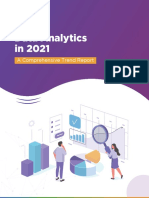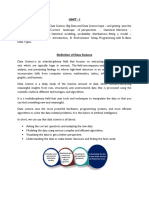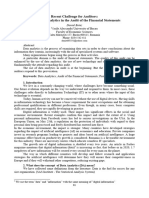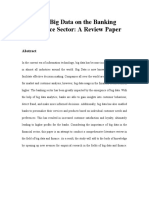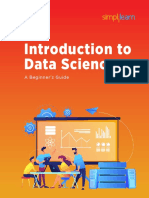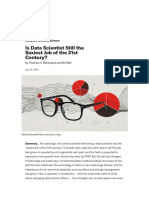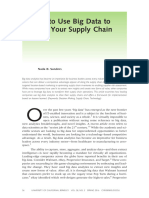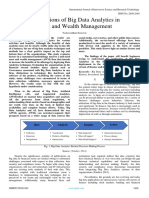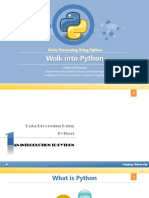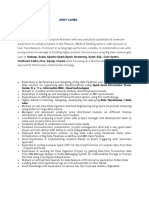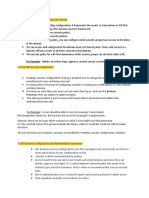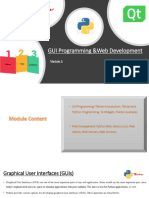Research On Data Science, Data Analytics and Big Data Rahul Reddy Nadikattu
Research On Data Science, Data Analytics and Big Data Rahul Reddy Nadikattu
Uploaded by
Colin StantosCopyright:
Available Formats
Research On Data Science, Data Analytics and Big Data Rahul Reddy Nadikattu
Research On Data Science, Data Analytics and Big Data Rahul Reddy Nadikattu
Uploaded by
Colin StantosOriginal Title
Copyright
Available Formats
Share this document
Did you find this document useful?
Is this content inappropriate?
Copyright:
Available Formats
Research On Data Science, Data Analytics and Big Data Rahul Reddy Nadikattu
Research On Data Science, Data Analytics and Big Data Rahul Reddy Nadikattu
Uploaded by
Colin StantosCopyright:
Available Formats
International Journal of Engineering, Science and Mathematics
Vol.9Issue 05, May2020
ISSN: 2320-0294 Impact Factor: 6.765
Journal Homepage: http://www.ijmra.us, Email: editorijmie@gmail.com
Double-Blind Peer Reviewed Refereed Open Access International Journal - Included in the International Serial Directories Indexed &
Listed at: Ulrich's Periodicals Directory ©, U.S.A., Open J-Gage as well as in Cabell‘s Directories of Publishing Opportunities, U.S.A
RESEARCH ON DATA SCIENCE, DATA ANALYTICS AND BIG DATA
Rahul Reddy Nadikattu
University of the Cumberlands United States
BIG DATA:
Big Data refers to a huge volume of data of various types, i.e., structured, semi structured,
and unstructured. This data is generated through various digital channels such as mobile,
Internet, social media, e-commerce websites, etc. Big Data has proven to be of great use
since its inception, as companies started realizing its importance for various business
purposes. Now that the companies have started deciphering this data, they have witnessed
exponential growth over the years.Impact on various sectors like Retail, Banking and
investment, Fraud detection and analyzing, Customer-centric applications and Operational
analysis
DATA SCIENCE
Data Science deals with the slicing and dicing of the big chunks of data, as well as finding
insightful patterns and trends from them using technology, mathematics, and statistical
techniques. Data Scientists are responsible for uncovering the facts hidden in the complex
web of unstructured data so as to be used in making business decisions. Data Scientists
perform the aforementioned job by developing heuristic algorithms and models that can be
used in the future for significant purposes. This amalgamation of technology and concepts
makes Data Science a potential field for lucrative career opportunities. McKinsey once
predicted that there will be an acute shortage of Data Science Professionals in the next
decade. Impact on various sectors like Web development, Digital advertisements, E-
commerce, Internet search, Finance, Telecom, Utilities.
DATA ANALYTICS:
Data Analytics seeks to provide operational insights into complex business situations. The
concept of big data has been around for years; most organizations now understand that if
they capture all the data that streams into their businesses, they can apply analytics and get
significant value from it. But even in the 1950s, decades before anyone uttered the term
99 International Journal of Engineering, Science and Mathematics
http://www.ijmra.us, Email: editorijmie@gmail.com
Electronic copy available at: https://ssrn.com/abstract=3622844
ISSN: 2320-0294Impact Factor: 6.765
―big data,‖ businesses were using basic analytics (essentially numbers in a spreadsheet that
were manually examined) to uncover insights and trends. he new benefits that big data
analytics brings to the table, however, are speed and efficiency. Whereas a few years ago a
business would have gathered information, run analytics and unearthed information that
could be used for future decisions, today that business can identify insights for immediate
decisions. The ability to work faster – and stay agile – gives organizations a competitive
edge they didn‘t have before. Looking into the historical data from a modern perspective,
finding new and challenging business scenarios and applying methodologies to find a
better solution are the prime concerns of a Data Analyst. Not only this, but a Data Analyst
also predicts the upcoming opportunities which the company can exploit. Data Analytics
has shown such a tremendous growth across the globe that soon the Big Data market
revenue is expected grow by 50 percent.Impact on various sectors like Traveling and
transportation, Financial analysis, Retail, Research, Energy management, Healthcare.
Data is the baseline for almost all activities performed today, whether it is in the field of
education, research, healthcare, technology, retail, or any other industry. The orientation of
businesses has changed from being product-focused to data-focused. Even a small piece of
information is valuable for companies nowadays, making it essential for them to derive
more and more information possible. This necessity gave rise to the need for experts who
could bring meaningful insights.It is evident from this table how these areas impact our
economy. Actually, technologies are helping diverse sectors in a great way, allowing them
to put each and every piece of insight into use. While Big Data is helping the retail,
banking, and other industries by providing some of the important technologies such as
fraud-detection systems, operational analysis systems, etc., Data Analytics allows the
industries of healthcare, banking, traveling and transport, energy management, etc. to come
up with new advancements using the historical trends. On the other hand, Data Science is
letting the companies get into web development, digital advertisements, e-commerce, etc.,
and dive deep into the granular information for different purposes. Data Scientists perform
the most challenging jobs among the three. Data Scientist is one of the most trending
profiles in the 21st century. There is considerable overlapping of roles between Data
Analysts and Big Data Professionals. Data Science is booming like anything and hence has
been tagged as the sexiest job of the 21st century by Forbes. Skill sets required to become
Data Scientists, Data Analysts, and Big Data Professionals are different. Though there are
some skills that are common in all the three profiles, the level of proficiency varies as per
100 International Journal of Engineering, Science and Mathematics
http://www.ijmra.us, Email: editorijmie@gmail.com
Electronic copy available at: https://ssrn.com/abstract=3622844
ISSN: 2320-0294Impact Factor: 6.765
the job roles. Therefore, you should clearly know what you want to become and what skills
you need to have for that. In order to become a Data Scientist, you need to be proficient in
mathematics, statistics, programming, and business strategies. You should have good
communication skills, as a Data Scientist needs to distribute the information to various
departments of an organization. Similarly, a Big Data Professional would require having a
good grasp of technology (such as Hadoop and Java), mathematics, and statistics, as well
as analytics. However, a Data Analyst needs to be good in programming, Artificial
Intelligence, and data wrangling. While many people use the terms interchangeably, data
science and big data analytics are unique fields, with the major difference being the scope.
Data science is an umbrella term for a group of fields that are used to mine large datasets.
Data analytics is a more focused version of this and can even be considered part of the
larger process. Analytics is devoted to realizing actionable insights that can be applied
immediately based on existing queries. Data science isn‘t concerned with answering
specific queries, instead parsing through massive datasets in sometimes unstructured ways
to expose insights. Data analysis works better when it is focused, having questions in mind
that need answers based on existing data. Data science produces broader insights that
concentrate on which questions should be asked, while big data analytics emphasizes
discovering answers to questions being asked.More importantly, data science is more
concerned about asking questions than finding specific answers. The field is focused on
establishing potential trends based on existing data, as well as realizing better ways to
analyze and model dataThe two fields can be considered different sides of the same coin,
and their functions are highly interconnected. Data science lays important foundations and
parses big datasets to create initial observations, future trends, and potential insights that
can be important. This information by itself is useful for some fields, especially modeling,
improving machine learning, and enhancing AI algorithms as it can improve how
information is sorted and understood. However, data science asks important questions that
we were unaware of before while providing little in the way of hard answers. By adding
data analytics into the mix, we can turn those things we know we don‘t know into
actionable insights with practical applications Big Data for financial services: Credit card
companies, retail banks, private wealth management advisories, insurance firms, venture
funds, and institutional investment banks use big data for their financial services. The
common problem among them all is the massive amounts of multi-structured data living in
multiple disparate systems which can be solved by big data. Thus big data is used in
several ways like: Customer analytics, Compliance analytics, Fraud analytics, Operational
101 International Journal of Engineering, Science and Mathematics
http://www.ijmra.us, Email: editorijmie@gmail.com
Electronic copy available at: https://ssrn.com/abstract=3622844
ISSN: 2320-0294Impact Factor: 6.765
analytics. Big Data in Communications: Gaining new subscribers, retaining customers, and
expanding within current subscriber bases are top priorities for telecommunication service
providers. The solutions to these challenges lie in the ability to combine and analyze the
masses of customer-generated data and machine-generated data that is being created every
day.Big Data for Retail: Brick and Mortar or an online e-tailer, the answer to staying the
game and being competitive is understanding the customer better to serve them. This
requires the ability to analyze all the disparate data sources that companies deal with every
day, including the weblogs, customer transaction data, social media, store-branded credit
card data, and loyalty program data.Healthcare: The main challenge for hospitals with cost
pressures tightens is to treat as many patients as they can efficiently, keeping in mind the
improvement of the quality of care. Instrument and machine data is being used increasingly
to track as well as optimize patient flow, treatment, and equipment used in the hospitals. It
is estimated that there will be a 1% efficiency gain that could yield more than $63 billion
in global healthcare savings. Travel: Data analytics is able to optimize the buying
experience through mobile/ weblog and social media data analysis. Travel sights can gain
insights into the customer‘s desires and preferences. Products can be up-sold by correlating
the current sales to the subsequent browsing increase browse-to-buy conversions via
customized packages and offers. Personalized travel recommendations can also be
delivered by data analytics based on social media data. Gaming: Data Analytics helps in
collecting data to optimize and spend within as well as across games. Game companies
gain insight into the dislikes, the relationships, and the likes of the users.Energy
Management: Most firms are using data analytics for energy management, including smart-
grid management, energy optimization, energy distribution, and building automation in
utility companies. The application here is centered on the controlling and monitoring of
network devices, dispatch crews, and manage service outages. Utilities are given the ability
to integrate millions of data points in the network performance and lets the engineers use
the analytics to monitor the network.We have made tremendous progress in the field of
Information & Technology in recent times. Some of the revolutionary feats achieved in the
tech-ecosystem are really commendable. Data and Analytics have been the most
commonly used words in the last decade or two. As such, it‘s important to know why they
are inter-related, what roles in the market are currently evolving and how they are
reshaping businesses.Technology often regarded as a boon to those already aware of its
potential, can also be a curse to audiences who can‘t keep up with it‘s rapid growth. Each
era has had it‘s moments of breakthrough and an equal share of victims (or as I‘d like to
102 International Journal of Engineering, Science and Mathematics
http://www.ijmra.us, Email: editorijmie@gmail.com
Electronic copy available at: https://ssrn.com/abstract=3622844
ISSN: 2320-0294Impact Factor: 6.765
call them collateral damage). As of today, every monetary-driven industry completely
relies on Data and Analytics for it‘s survival.This was the uprising of Data warehouse
where customer (Business) and production processes (Transactions) were centralized into
one huge repository like eCDW (Enterprise Consolidated Data Warehouse) . A real
progress was established in gaining an objective, deep understanding of important business
phenomena — thereby giving managers the fact-based comprehension to go beyond
intuition when making decisions.The data surrounding eCDW was captured , transformed
and queried using ETL & BI tools. The type of analytics exploited during this phase was
mainly classified as Descriptive (what happened) and Diagnostic (why something
happened).However , The main limitations observed during this era were that the potential
capabilities of data were only utilized within organizations , i.e. , the business intelligence
activities addressed only what had happened in the past and offered no predictions about
it‘s trends in the future.The certain drawbacks of the previous era became more prominent
by the day as companies stepped out of their comfort-zone and began their pursuit of a
wider (if not better) approach towards attaining a sophisticated form of analytics.
Customers surprisingly reacted well to this new strategy and demanded information from
external sources (clickstreams , social media , internet , public initiatives etc) . The need
for powerful new tools and the opportunity to profit by providing them — quickly became
apparent. Inevitably , the term ‗Big data‘ was coined to distinguish from small data, which
is generated purely by a firm‘s internal transaction systems.What companies expected from
their employees was to help engineer platforms to handle large volumes of data with a fast-
processing engine . What they didn‘t expect was a huge response from an emerging group
of individuals or what is today better known as the ―Open Source Community‖. This was
the hallmark of Analytics 2.0.With the unprecedented backing of the community , Roles
like Big-Data Engineers & Hadoop Administrators grew in the job-sector and were now
critical to every IT organization. Tech-firms rushed to build new frameworks that were not
only capable of ingesting , transforming and processing big-data around eCDW/Data Lakes
but also integrating Predictive (what is likely to happen) analytics above it. This uses the
findings of descriptive and diagnostic analytics to detect tendencies, clusters and
exceptions, and to predict future trends, which makes it a valuable tool for forecasting. In
today‘s tech-ecosystem , I personally think the term big-data has been used, misused &
abused on many occasions. So technically, ‗big data‘ now really means ‗all data‘.The
pioneering big data firms began investing in analytics to support customer-facing products,
services, and features. They attracted viewers to their websites through better search
103 International Journal of Engineering, Science and Mathematics
http://www.ijmra.us, Email: editorijmie@gmail.com
Electronic copy available at: https://ssrn.com/abstract=3622844
ISSN: 2320-0294Impact Factor: 6.765
algorithms, recommendations , suggestions for products to buy, and highly targeted ads, all
driven by analytics rooted in enormous amounts of data. The outbreak of the Big-Data
phenomena spread like a virus. So, now it‘s not just tech-firms and online companies that
can create products and services from analysis of data, it‘s practically every firm in every
industry. On the other hand, the wide-acceptance for big-data technologies had a mixed
impact . While the tech-savvy giants forged ahead by making more money, a majority of
other enterprises & non-tech firms suffered miserably at the expense of not-knowing about
the data. As a result, a field of study Data Science was introduced which used scientific
methods, exploratory processes, algorithms and systems to extract knowledge and insights
from data in various forms.Indeed, an interdisciplinary field defined as a ―concept to unify
statistics, data analysis, machine learning and their related methods‖ in order to
―understand and analyse actual phenomena‖ with data. In other words , a well-refined data
combined with good training models would yield better prediction results. The next-
generation of quantitative analysts were called data scientists, who possessed both
computational and analytical skills.The tech-industry exploded with the benefits of
implementing Data Science techniques and leveraged the full power of predictive &
prescriptive (what action to take) analytics ,i.e, eliminate a future problem or take full
advantage of a promising trend. Companies began competing on analytics not only in the
traditional sense — by improving internal business decisions — but also by creating more
valuable products and services. This is the essence of Analytics 3.0. There has been a
paradigm shift in how analytics are used today. Companies are scaling at a speed beyond
imagination, identifying disruptive services, encouraging more R&D divisions — many of
which are strategic in nature. This requires new organizational structureThere have always
been four types of analytics: descriptive, which reports on the past; diagnostic, which uses
the data of the past to study the present; predictive, which uses insights based on past data
to predict the future; and prescriptive, which uses models to specify optimal behaviors and
actions. Although , Analytics 3.0 includes all of the above types in a broad sense, it
emphasizes the last . And it introduces — typically on a small scale — the idea of
automated analytics.Analytics 3.0 provides an opportunity to scale decision-making
processes to industrial strength. Creating many more models through machine learning can
let an organisation become much more granular and precise in its predictions. Having said
that ,the cost & time for deploying such customised models wasn‘t entirely affordable and
necessitated a cheaper or faster approach. The need for automation through intelligent
systems finally arrived , and this idea (once deemed as beyond-reach) that loomed on the
104 International Journal of Engineering, Science and Mathematics
http://www.ijmra.us, Email: editorijmie@gmail.com
Electronic copy available at: https://ssrn.com/abstract=3622844
ISSN: 2320-0294Impact Factor: 6.765
horizon is where Analytics 4.0 came into existence .There is no doubt that the use of
artificial intelligence, machine learning and deep learning is going to profoundly change
knowledge work. We have already seen their innovative capabilities in the form of Neural
Machine Translation, Smart Reply, Chat-bots, Meeting Assistants etc ,which will be
extensively used for the next couple of years. The data involved here originated from vast
heterogenous sources consisting of indigenous types — one that requires complex training
methods — and especially those that can sustain (make recommendations, improve
decision-making, take appropriate actions) itself. Employing data-mining techniques and
machine learning algorithms along with the existing descriptive-predictive-prescriptive
analytics comes to full fruition in this era. This is one reason why Automated Analytics is
seen as the next stage in analytic maturity.filled with the promise of a utopian society run
by machines and managed by peace-loving managers and technologists. We could reframe
the threat of automation as an opportunity for augmentation : combining smart humans and
smart machines to achieve an overall better result.
Now, instead of pondering ―What tasks currently employed by humans will soon be
replaced by machines?‖ I‘d rather optimistically question ―What new feats can companies
achieve if they have better-thinking machines to assist them? or How can we prevent death
tolls in a calamity-prone area with improved evacuation AI routines ? or Why can‘t AI-
driven e-schools be implemented in poverty-ridden zones ?‖ Most organisations that are
exploring ―cognitive‖ technologies — smart machines that automate aspects of decision-
making processes — are just putting a toe in the water. Some are doing pilots to explore
the technology. While others are working on the concept of building a Consumer-AI-
Controlled platform. These platforms use the idea of Personal AI agents that communicate
with other AI services or so called bots to get the job done. There will be no more manual
interventions necessary with just an AI-powered system to steer your personal day-to-day
activities. I wouldn‘t be surprised to see either of these technologies making giant leaps in
the future. Surely, there‘s an element of uncertainty tied to them but unlike many, I‘m
rather optimistic about the future.
105 International Journal of Engineering, Science and Mathematics
http://www.ijmra.us, Email: editorijmie@gmail.com
Electronic copy available at: https://ssrn.com/abstract=3622844
You might also like
- Sample IT Operational ManualDocument11 pagesSample IT Operational ManualArthur Ekow100% (1)
- Big Data Demystified - How To Use Big Data, Data Science and AI To Make Better Business Decisions and Gain Competitive AdvantageDocument196 pagesBig Data Demystified - How To Use Big Data, Data Science and AI To Make Better Business Decisions and Gain Competitive AdvantageAshfaque Reza100% (4)
- Chapter 9 Business Analytics AssignementsDocument7 pagesChapter 9 Business Analytics Assignementschris waltersNo ratings yet
- Data Science vs. Big Data vs. Data AnalyticsDocument7 pagesData Science vs. Big Data vs. Data AnalyticsLadines ClarisseNo ratings yet
- Introduction To Big Data Unit - 2Document75 pagesIntroduction To Big Data Unit - 2Sovit ChaudharyNo ratings yet
- Raw Data Science Personal StatementDocument5 pagesRaw Data Science Personal StatementBridget WallaceNo ratings yet
- ICT30005 - Assignment 1 - Begum Bolu 6623433 - Big Data AnalyticsDocument7 pagesICT30005 - Assignment 1 - Begum Bolu 6623433 - Big Data AnalyticsbboluNo ratings yet
- Big Data Research Papers PDF 2014Document5 pagesBig Data Research Papers PDF 2014yuyglccnd100% (1)
- What Is Big Data & Why Is Big Data Important in Today's EraDocument13 pagesWhat Is Big Data & Why Is Big Data Important in Today's EraMaanit Singal100% (1)
- The Role of Big DataDocument27 pagesThe Role of Big DataNina FilipovićNo ratings yet
- Big Data Use Cases: Product DevelopmentDocument8 pagesBig Data Use Cases: Product DevelopmentLanjriNo ratings yet
- Big Data Analytics ReportDocument37 pagesBig Data Analytics ReportVedant SinghNo ratings yet
- Big Data IntroductionDocument6 pagesBig Data Introductionpallavibhardwaj1125No ratings yet
- Dsbda U1 NewDocument6 pagesDsbda U1 Newtejasdeshmukh812No ratings yet
- Big Data Analytics: September 2015Document11 pagesBig Data Analytics: September 2015matheusNo ratings yet
- Big Data Analytics: September 2015Document11 pagesBig Data Analytics: September 2015matheusNo ratings yet
- Big DataDocument13 pagesBig DataKarishma HentryNo ratings yet
- Chapter 3 Big Data Analytics and Big Data Analytics Techniques PDFDocument22 pagesChapter 3 Big Data Analytics and Big Data Analytics Techniques PDFMamNo ratings yet
- Big Data Analysis GuideDocument11 pagesBig Data Analysis GuideAnonymous DLEF3GvNo ratings yet
- Data Analytics Trend Report Guide PDFDocument12 pagesData Analytics Trend Report Guide PDFMadhu kumarNo ratings yet
- Chapter 9 Questions and Case StudyDocument9 pagesChapter 9 Questions and Case Studychris waltersNo ratings yet
- Basic Data ScienceDocument2 pagesBasic Data SciencenitdrjothilakshmiNo ratings yet
- Unit 1Document55 pagesUnit 1Ramstage TestingNo ratings yet
- How Does Data Science Works in 2021Document9 pagesHow Does Data Science Works in 2021Pushpinder SainiNo ratings yet
- The Role of Big Data in Business and Decision Making: June 2022Document18 pagesThe Role of Big Data in Business and Decision Making: June 2022maryamNo ratings yet
- BDM 1Document37 pagesBDM 1Nirmal Kumar VNo ratings yet
- Ids Unit IDocument46 pagesIds Unit IOmer SohailNo ratings yet
- BIGDATAINBUSINESSDocument4 pagesBIGDATAINBUSINESSAnjali sinhaNo ratings yet
- Tran LetDocument11 pagesTran LetDesi rusfianiNo ratings yet
- Big Data: Opportunities and challengesFrom EverandBig Data: Opportunities and challengesBCS, The Chartered Institute for ITNo ratings yet
- Besufekad BIG DATA 1Document10 pagesBesufekad BIG DATA 1optionalforall07No ratings yet
- Artificial Intelligence Big Data 01 Research PaperDocument32 pagesArtificial Intelligence Big Data 01 Research PapermadhuraNo ratings yet
- Understanding of Big DataDocument25 pagesUnderstanding of Big Datarohitmarale77No ratings yet
- Big Data Applications and ToolsDocument16 pagesBig Data Applications and ToolsDr Amany MokhtarNo ratings yet
- R Programming UNIT-1Document48 pagesR Programming UNIT-1padmaNo ratings yet
- BDA Notes Unit-1Document18 pagesBDA Notes Unit-1Varshini DirishalaNo ratings yet
- How Innovative Oil and Gas Companies Are Using Big Data To Outmaneuver The CompetitionDocument12 pagesHow Innovative Oil and Gas Companies Are Using Big Data To Outmaneuver The Competition김형진No ratings yet
- 2053-Article Text-5361-1-10-20191011Document11 pages2053-Article Text-5361-1-10-20191011anshara nadeejaNo ratings yet
- Big Data Analytics and Healthcare - ProjectDocument10 pagesBig Data Analytics and Healthcare - ProjectGauravNo ratings yet
- Review PaperDocument6 pagesReview PaperAkriti SharmaNo ratings yet
- GTB Big Data Whitepaper (DB0324) v2 PDFDocument28 pagesGTB Big Data Whitepaper (DB0324) v2 PDFdgnyNo ratings yet
- Big Data Analytics: Challenges and Applications For Text, Audio, Video, and Social Media DataDocument11 pagesBig Data Analytics: Challenges and Applications For Text, Audio, Video, and Social Media DataijscaiNo ratings yet
- 00 Big Data and Business Analytics - Trends, Platforms, Success Factors and ApplicationsDocument31 pages00 Big Data and Business Analytics - Trends, Platforms, Success Factors and ApplicationsFabella Rizky NaumiNo ratings yet
- Big Data: The Definitive Guide To The Revolution in Business AnalyticsDocument66 pagesBig Data: The Definitive Guide To The Revolution in Business AnalyticsNilesh PatilNo ratings yet
- Introduction To Data Science - A Beginner GuideDocument18 pagesIntroduction To Data Science - A Beginner GuideVigna CulattaNo ratings yet
- Big Data Research Papers PDF 2016Document8 pagesBig Data Research Papers PDF 2016gz8te40w100% (1)
- Big Data: Unleashing the Power of Data to Transform Industries and Drive InnovationFrom EverandBig Data: Unleashing the Power of Data to Transform Industries and Drive InnovationNo ratings yet
- (DSBDA) Unit 1 Introduction To Data ScienceDocument14 pages(DSBDA) Unit 1 Introduction To Data SciencecallhimsidNo ratings yet
- Is Data Scientist Still the Sexiest Job of the 21st Century_Document8 pagesIs Data Scientist Still the Sexiest Job of the 21st Century_9hnvmfwkg2No ratings yet
- how to use big data to drive your supply chainDocument23 pageshow to use big data to drive your supply chainlucthanh83No ratings yet
- GITR Chapter1.7 2012Document8 pagesGITR Chapter1.7 2012krishnanandNo ratings yet
- Data Science: How Do Data Scientists Mine Out Insights?Document7 pagesData Science: How Do Data Scientists Mine Out Insights?Jansen Alonzo BordeyNo ratings yet
- Bigdata Mod-1Document33 pagesBigdata Mod-1preeti sahuNo ratings yet
- Big Data To Big Impact: Effect of Big Data in Modern Decision MakingDocument11 pagesBig Data To Big Impact: Effect of Big Data in Modern Decision MakingmaryamNo ratings yet
- Big Data Term PaperDocument6 pagesBig Data Term Paperaflsiosbe100% (1)
- Big Data AnalyticsDocument126 pagesBig Data AnalyticsDisha Sharma100% (1)
- Unit 2 Notes Data AnalyticsDocument11 pagesUnit 2 Notes Data AnalyticsShubham JainNo ratings yet
- Applications of Big Data Analytics in Asset and Wealth ManagementDocument6 pagesApplications of Big Data Analytics in Asset and Wealth ManagementInternational Journal of Innovative Science and Research TechnologyNo ratings yet
- Assignment: Ce Marketing Research & Data AnalyticsDocument7 pagesAssignment: Ce Marketing Research & Data AnalyticsAnwar khanNo ratings yet
- What Is Big Data?: Examples of Big Data: Applications of Big Data in Real LifeDocument4 pagesWhat Is Big Data?: Examples of Big Data: Applications of Big Data in Real LifeNusrat Sharmin LiunaNo ratings yet
- BDA Class1Document26 pagesBDA Class1Celina SawanNo ratings yet
- Paas Iaas Universal Credits 3940775Document92 pagesPaas Iaas Universal Credits 3940775emedinillaNo ratings yet
- How To Compile Opencv With Gstreamer (Ubuntu&Windows) : Galaktyk 01Document14 pagesHow To Compile Opencv With Gstreamer (Ubuntu&Windows) : Galaktyk 01Đinh LuậnNo ratings yet
- Big Data Introduction PDFDocument29 pagesBig Data Introduction PDFMODA ZINANo ratings yet
- DBMS Chapter2 Concepts and ArchitectureDocument20 pagesDBMS Chapter2 Concepts and ArchitectureVcoid GrenadeNo ratings yet
- Servicedesk Plus: Product Overview Presented byDocument40 pagesServicedesk Plus: Product Overview Presented byJose Luis Holguin S.No ratings yet
- Principles of Programming Languages (1) - Unit-4Document25 pagesPrinciples of Programming Languages (1) - Unit-4roshini kandagatlaNo ratings yet
- Namara Cynthia EreenDocument47 pagesNamara Cynthia EreenChiedozieNo ratings yet
- ETSI NFVO Compliant Orchestration in KubernetesDocument26 pagesETSI NFVO Compliant Orchestration in KuberneteslaboticseguroNo ratings yet
- Indexing: ContentsDocument13 pagesIndexing: ContentsMinhaz Kamal 2No ratings yet
- IBM TS7610 PortecTIER Deduplication Appliance Overview - TSD03107USENDocument2 pagesIBM TS7610 PortecTIER Deduplication Appliance Overview - TSD03107USENRaymund CatiisNo ratings yet
- Walk Into Python: Data Processing Using PythonDocument68 pagesWalk Into Python: Data Processing Using Pythontemp 2No ratings yet
- Welcome To Oracle Business Intelligence Tools 10g (10.1.2) : Quick TourDocument2 pagesWelcome To Oracle Business Intelligence Tools 10g (10.1.2) : Quick TourtejukmNo ratings yet
- Variant ConfigurationDocument93 pagesVariant Configurationkannanraj666100% (6)
- r12 Online Accruals 2 Ver04Document86 pagesr12 Online Accruals 2 Ver04JanardhanNo ratings yet
- Relation Data ModelDocument22 pagesRelation Data ModelKhushboo AgarwalNo ratings yet
- Adpatch BasicsDocument37 pagesAdpatch BasicsArindam DebrayNo ratings yet
- Mohammed Shafi: Work ExperienceDocument3 pagesMohammed Shafi: Work ExperienceDhanashree HiwaseNo ratings yet
- Name: Date of Birth: Nationality: Idioms:: Contact: +55 11 930035119Document3 pagesName: Date of Birth: Nationality: Idioms:: Contact: +55 11 930035119Carlos AlmeidaNo ratings yet
- Jimmy Lamba Resume PDFDocument8 pagesJimmy Lamba Resume PDFAnisha KoushalNo ratings yet
- Laporan 2 PLSQL Develop Program Unit Basis Data Lanjut - 2103171008 - Rintan Aprilia PratiwiDocument12 pagesLaporan 2 PLSQL Develop Program Unit Basis Data Lanjut - 2103171008 - Rintan Aprilia PratiwiRintan Yuri AprilliaNo ratings yet
- My Workday Experience On SecurityDocument2 pagesMy Workday Experience On SecurityBhimavarapu RamiReddyNo ratings yet
- Power Query KevalDocument2 pagesPower Query KevalgpNo ratings yet
- Professional Scrum Dev GlossaryDocument5 pagesProfessional Scrum Dev GlossaryHarshNo ratings yet
- Python - Module-5 (1) 1Document54 pagesPython - Module-5 (1) 1Anit JamesNo ratings yet
- Data Definition Commands, Data Manipulation Commands For Inserting, Deleting, Updating and Retrieving TablesDocument11 pagesData Definition Commands, Data Manipulation Commands For Inserting, Deleting, Updating and Retrieving Tables11 DHANUSIKA MNo ratings yet
- CCNA Exploration 2 - Module 5 Exam Answers Version 4.0Document3 pagesCCNA Exploration 2 - Module 5 Exam Answers Version 4.0fun kollaNo ratings yet
- Introduction To Micro ServicesDocument46 pagesIntroduction To Micro ServicesNikita PatelNo ratings yet
- Lecture 3.1 and 3.2 Relational AlgebraDocument36 pagesLecture 3.1 and 3.2 Relational AlgebraSrinibas PattanaikNo ratings yet
- Business Case For EA - IserverDocument23 pagesBusiness Case For EA - IserverNishant KulshresthaNo ratings yet



















